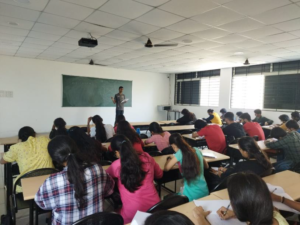Announcements >>
Announcements >>
Innovative Teaching Method: Role Play on Linked Lists
By: Mr. Srinidhi
As part of our commitment to experiential and innovative teaching, I recently organized an engaging classroom activity to help students grasp the concept of single linked lists in our data structures course. Understanding linked lists is fundamental in computer science, yet students often find it challenging to visualize how nodes connect, how memory allocation works, and how data is managed dynamically in such structures. To address this, I introduced a hands-on role-play exercise, transforming theoretical concepts into a memorable, active learning experience.
In this activity, students represented individual nodes in a single linked list, each holding a “value” and an “address” board to simulate the data and pointer elements within the list. The exercise aimed to reinforce the structure of a linked list by physically demonstrating how nodes link to one another and how data flows from one node to the next. The participating students included Shamantha, Vijayakrishna, Shreyas Prahalad Joshi, Prajna Nayak, Skanda Shanbog, Shreya, Sathya Swaroop, Sharanya, Sudhanva, and Srikanth. Each student enthusiastically took on their role, embodying both the logical and spatial aspects of linked lists.
During the role-play, we simulated adding, deleting, and traversing nodes within the linked list. For example, when adding a node, a student would step in with their address board updated, demonstrating the seamless linking process visually for their classmates. Similarly, for node deletion, students observed how one “node” (or student) could be removed without disrupting the overall link sequence, enhancing their understanding of memory management and pointer adjustments.
The feedback from students was overwhelmingly positive. This practical approach allowed them to “see” how a linked list operates, making the abstract concept tangible and accessible. As they embodied the functionality of each node, students developed a stronger intuition for how linked lists work, preparing them for more complex data structures in the future.
The activity emphasized the value of active learning, showing that when students engage with core concepts creatively, their understanding deepens, and the knowledge gained is more likely to be retained. As an educator, I found this approach effective in boosting student confidence in their comprehension of linked lists, and I look forward to incorporating more such activities into our computer science curriculum.


